1 About the philosophy in Goju-Ryu karate
剛柔流空手と東洋哲学
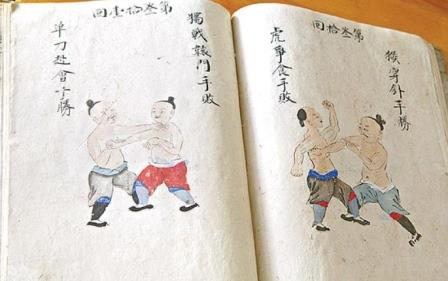
..流派名の多くは創設者の名前に由来している。たとえば「松濤」は船越義珍の雅号であり「糸東」は糸洲安恒と東恩納寛量の頭文字の組み合わせである。上地流は創始者そのものの姓である。
しかし「剛柔」違う。「沖縄伝統武備志」の「法は剛柔を呑吐す」に由来する哲学的概念である。「法」は中国哲学において真実、存在、超越などを意味する形而上学的概念である。老荘思想では
「道(タオ)」という言葉で表現する。老子は道 を「道は為すなくして為さざるなし」と説明している。
剛柔流の「剛」はパンチとキックを、「柔」は関節技の投げ技を表すと説明されがちである。しかしそれは表面的な解釈である。確かに剛は直線的で力強い動きを、柔は柔らかい円の動きを象徴するが、この概念は物理的な面だけでなく精神的な面も含む。それぞれがお互いの存在にとって重要な契機であり条件であって、剛柔流の真髄はこの有機的な動きの中に存在する。剛柔の概念は「沖縄伝武備志」の一節、王岳登先生「羅漢拳法を論ず」でより論じられている。
沖縄の空手は本土の武士道と異なる独特の世界観の中に在る。東シナ海文化圏の道教思想に由来するものだろう。沖縄伝「武備志」をもとにそれについて以下に解説する。
Many Ryu-ha names originate from the founders' names. For instance, "Shoto"
is the pen name of Funakoshi Gichin, while "Shito" combines the
initials of two initiators, Ito Su Ankou and Higaonna Kanryo. Uechi-ryu
is named after its initiator's family name.
However, "Goju"-ryu has a different origin; it comes from the proverb 法は剛柔を呑吐す (HOU wa GO-JU o dondo su), found in the ancient military text "Bubushi"
in Okinawa.What do the terms HOU (法), GO (剛), and JU (柔) mean? HOU (法)
represents a metaphysical concept signifying Truth, Existence, and Transcendence.
It is often expressed by the word "TAO (道)
Okinawa Karate has a unique worldview that is different from the mainland's
Bushido. This is probably a worldview derived from Chinese Taoism. The
concept of "goju" (hard and soft) is discussed in a passage from
"Okinawa Den Bubishi" and in Wang Yuetong Roshi's "Arhat
Kempo."Based on the "Okinawaden Bubishi", it is explained
below.
1-1The Eight Principles of Karate in the Bubushi. 拳法之大要八句
(1)人心同天地 人心は天地と同じ
"Jin shin wa ten chi to onaji "
..The human spirit and body mirror the movement of heaven and earth....
(2)血脈似日月 血脈は日月に似たり
"Ketsu-myaku wa nichi-getsu ni nitari"
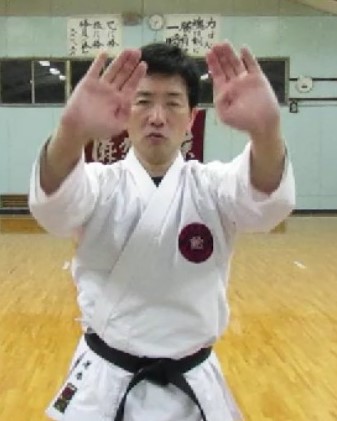 ..The flow of blood resembles the movement of the sun and moon. We, as
Karate-ka, exist within nature, and our goal should be to understand and
harmonize with it. Our aim is to cultivate a stable mind and body, naturally
integrated and at peace. The ultimate stage of Karate is equivalent to
the highest level of Zen, known in Eastern philosophy as Mui-Shizen (無為自然), or "abandoning artifice and simply being oneself." Karate
is truly a way of life. ..The flow of blood resembles the movement of the sun and moon. We, as
Karate-ka, exist within nature, and our goal should be to understand and
harmonize with it. Our aim is to cultivate a stable mind and body, naturally
integrated and at peace. The ultimate stage of Karate is equivalent to
the highest level of Zen, known in Eastern philosophy as Mui-Shizen (無為自然), or "abandoning artifice and simply being oneself." Karate
is truly a way of life.
(3)法剛柔呑吐 法は剛柔を呑吐す"hou wa go-ju o donto su"
..Truth has two facets: one hard and one soft. Both manifest naturally and
adaptively, like the rhythm of human breath.
(4)身随時応変 身は随時応変す "mi wa zuiji ou hen su"
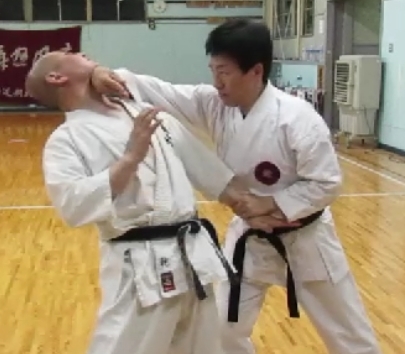 The body moves with natural flexibility, and true technique arises effortlessly
from a state of mindlessness. The body moves with natural flexibility, and true technique arises effortlessly
from a state of mindlessness.
(5)手目逢空則入 空に遭えば手すなわち入る
 "Syu-moku wa kuu ni aeba sunawachi hairu" "Syu-moku wa kuu ni aeba sunawachi hairu"
The moment see an opening,Attack the enemy .
(6)碼進退離遭 進退は謀りて着離す
"shintai wa hakarite cyaku-ri su"
naturally approaches and separates from the opponent depending on the distance.
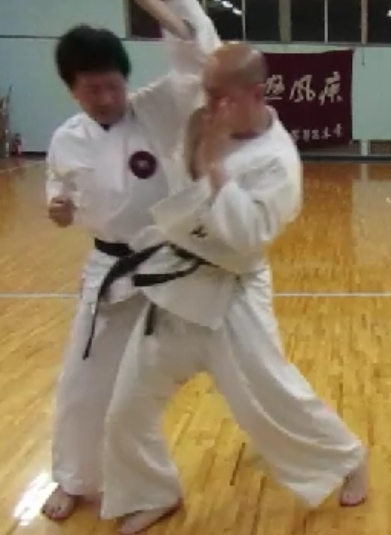
(7)目要観四向 "me wa shihou o mirukoto o yousu""
The eyes must see 360 degrees

(8)耳能聴听八方 "mimi wa yoku happou o choukin su"
The ears must hear the sound from all directions.
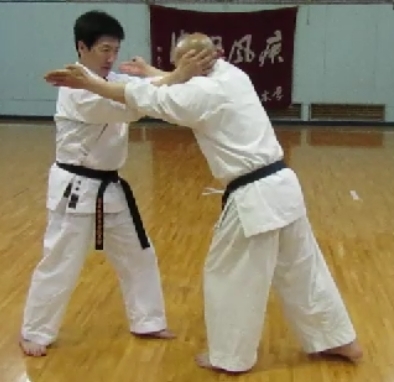
王岳登先生「羅漢拳法を論ず」より 沖縄伝武備志
Maxims for Karate-ka
From the "Bubishi" by Wai Shizan (Wang Shijiang)
1.The True Hero 英雄について
真の英雄は注目されることを求めない。真に勇敢な人は心が優しく暴言を慎む。熱心な空手家は常に謙虚であり、決して傲慢な態度を示さず誠実な敬意を持って他者に接する。真の達人は自分の技術をひけらかさず、その奥義は隠したままである。
A true hero is not one who seeks to be seen. The genuinely courageous
are tender in spirit, refraining from abusive words. A dedicated Karate-karemains
humble, never displaying arrogance, and treats others with sincererespect.
The true master does not flaunt their skill; true expertise remainshidden.
2.Choosing Companions Wisely 賢く仲間を選ぶこと
仲間を賢く選ぶ、 知識を共有したり秘密を掘り下げたりできる価値のある友人を探せ。空手家は、たとえ些細な事であっても、常に謙虚さを示すべきである。良い友人に出会ったときは一緒に洞察することを共有し、誠実さに欠ける友人との付き合いは避けるべきである。悪い仲間は多くの貴重な人間関係を蝕む。
Seek a worthy friend with whom you can share knowledge and delve intosecrets. A Karate-ka should always show modesty,even in the smallest matters.
When you meet a good friend, share insights together, but avoid associatingwith
those who lack integrity; bad company erodes many valuable relationships.
3.Facing a Strong Opponent 強敵と対峙する
強敵に対峙するときは恐怖を隠し平静を保つこと。本当の技術は絶望に打ち勝つことで成長する。相手が直線で攻撃してきた場合は円を描く動きで反撃せよ。相手が円を描いて攻撃してきた場合は、直線で応せよ。
When facing a formidable enemy, maintain composure and do not displayfear.
True technique falters when overcome by desperation. If the opponent strikes
in a straight line, counter with circular movement. If they attack in a
circle, respond with a straight approach.
4.Balance and Movement バランスと動き
バランスとフットワークのコントロールが重要である。姿勢を保ちながら上手に前進・後退する能力を養うこと。攻撃は上から来ることも下から来ることもありそのバリエーションは無限大で、雲から落ちる雷のように、あるいは夜の月光や流星のように襲いかかっくる。手足だけでなく体全体を意識して訓練し、武道の真理を明らかにすべし。
Control of balance and footwork is crucial. Cultivate the ability to advanceand
retreat skillfully, maintaining a strong posture. Attack may come fromabove
or below, and its variations are endless. Strike like thunder froma cloud,
or like moonlight and a meteor in the night. Train not only the hands but
the entire body with mindful practice, refining strength to reveal truth.
Key Principles of Attack and Defense
- To strike the enemy’s east, first divert attention to the west.
- To attack head-on, keep an eye on the enemy’s rear.
- Use your back for softer, controlled power.
- If the enemy grabs your hand, target their thumb.
- Employ feints to mislead and overcome the enemy.
- Encourage the enemy to lower their guard when they are down.
- Strike the back of the enemy’s head if they cling to you.
- Target the enemy’s vital point if they cling tightly.
- Attack the enemy’s throat if they attempt to bite.
- Strike the enemy’s face if they grip your head.
- Use a thrusting “nukite” strike if approached suddenly.
- Use a kick if the enemy begins to move away.
- To attack the enemy’s left, first target their right side.
- Begin with the enemy’s hand when attempting to step on and disable their foot.
- Shift your center of gravity backward for a high kick.
- Use “nukite” to strike the enemy’s face if they twist your hand.
- Use a “nukite” thrust if the enemy grips your sleeve.
- Use a knee strike (“hizageri”) if the enemy grabs your trousers.
- Punch as the enemy charges forward.
- For an enemy who prefers to kick, try hooking and lifting their leg.
- Avoid kicking when the enemy is in a low stance.
- Prepare for close combat if the enemy takes a high stance.
- Attack the enemy’s upper body if they aim low.
- Duck and evade quickly if the enemy grabs your hair.
- Use joint locks if the enemy reaches for your throat.
- Dodge an enemy’s kick from all sides rather than blocking with your arm.
- A strong move is to attack the enemy’s hand and foot simultaneously.
.厳密に言うと沖縄と日本本土は武士道や侍文化を共有していない。沖縄が日本国に編入されたのは侍の時代の終わった後である。だから沖縄の空手道場には侍文化の作法も鹿島大明神や香取大明神の神前も存在しない。もし海外の空手修行者がそれらに期待して沖縄にくるとしたら、その点については失望するだろう。沖縄は中国南方文化圏であり道教文化圏である。
..船越義珍や宮城長順、摩文仁賢和らの悲願は地方武術にすぎなかった空手を日本国の正当な武道のひとつに加えることにあった。彼らは実に意欲的に旧制大学の学生に教授し、旧制(1895-1946)大日本武徳会の錬士や教士の称号を獲得するために奔走した。しかし空手は琉球の不可思議な土着武術だというイメージは固着して残った。21世紀には逆にそれを前面に出して沖縄空手としての市場を開拓している。 ..Strictly speaking, Okinawa—the birthplace of Karate—had little connection
to the Japanese Samurai tradition. Until 1879, Okinawa was part of the
Ryukyu Kingdom, a distinct nation heavily influenced by China. Therefore,
Karate dojos in Okinawa do not pay homage to the deities of Japanese Samurai,
such as Kashima-daimyoujin (鹿島大明神) and Katori-daimyoujin (香取大明神).
Okinawan culture does not incorporate Zen philosophy or the life principles
often associated with Samurai values. As a result, a foreigner seeking
the spirit of Bushido in Okinawa will not find it in traditional Karate.
Unlike Japanese martial arts like Kendo, Judo, and Kyudo, which emphasize
philosophical principles as much as technique, Okinawan Karate is rooted
in southern Chinese and Taoist traditions.
Chojun Miyagi, Kenwa Mabuni, and Gichin Funakoshi aspired to see Okinawan
Karate recognized within the sphere of Japanese Budo. They sought affiliation
with the Dai Nippon Butokukai (Greater Japan Martial Virtue Society; 1895–1946)
and worked hard to earn titles such as Renshi and Kyoshi within this organization.
Although they achieved this recognition, Karate did not share the same
history or philosophy as Japanese Budo, leaving it as something of an “outsider.”
This distinction contributed to a long-standing perception of Karate as
a rough, lower-rank martial art.. |
 Philosophy of Karate last update revised in Nov.2, 2024 HOME
Philosophy of Karate last update revised in Nov.2, 2024 HOME
 ..The flow of blood resembles the movement of the sun and moon. We, as
Karate-ka, exist within nature, and our goal should be to understand and
harmonize with it. Our aim is to cultivate a stable mind and body, naturally
integrated and at peace. The ultimate stage of Karate is equivalent to
the highest level of Zen, known in Eastern philosophy as Mui-Shizen (無為自然), or "abandoning artifice and simply being oneself." Karate
is truly a way of life.
..The flow of blood resembles the movement of the sun and moon. We, as
Karate-ka, exist within nature, and our goal should be to understand and
harmonize with it. Our aim is to cultivate a stable mind and body, naturally
integrated and at peace. The ultimate stage of Karate is equivalent to
the highest level of Zen, known in Eastern philosophy as Mui-Shizen (無為自然), or "abandoning artifice and simply being oneself." Karate
is truly a way of life. The body moves with natural flexibility, and true technique arises effortlessly
from a state of mindlessness.
The body moves with natural flexibility, and true technique arises effortlessly
from a state of mindlessness. "Syu-moku wa kuu ni aeba sunawachi hairu"
"Syu-moku wa kuu ni aeba sunawachi hairu"

